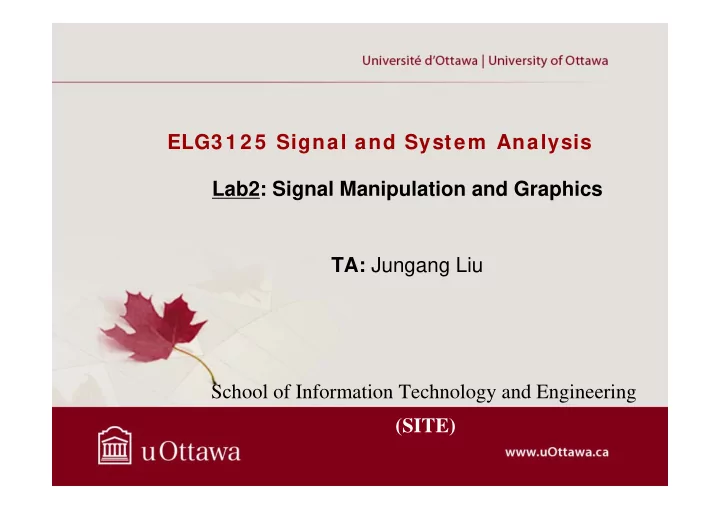

ELG3 1 2 5 Signal and System Analysis Lab2: Signal Manipulation and Graphics TA: Jungang Liu School of Information Technology and Engineering (SITE)
Outline 1. Periodic Signals 2. Signal Combination 3. Matlab Graphing http://www.mathworks.com MATLab Manual ELG3125 Signal and System Analysis Fall 2010 School of Information Technology and Engineering
Continuous-Time Sinusoidal Signals � Sine signal with period T: 1 π 2 0.8 = y sin( t ) 0.6 T 0.4 � Example: 0.2 0 T=6; %Period -0.2 t=0:0.01:60; -0.4 -0.6 y=sin(2*pi/T.*t); -0.8 plot(t,y),grid; -1 0 10 20 30 40 50 60 ELG3125 Signal and System Analysis Fall 2010 School of Information Technology and Engineering
Exponential Function Signal 150 � Exponential function ω t = 0 x e 100 � Example: t=0:0.01:20; omega=1; ; 50 y=exp(omega .*t); plot(t,y),grid; 0 0 0.5 1 1.5 2 2.5 3 3.5 4 4.5 5 ELG3125 Signal and System Analysis Fall 2010 School of Information Technology and Engineering
Plot Two Continuous-time Signals in One Graph (Method1) 1 0.8 � Use plot function 0.6 %Sinusoidal 1 0.4 T=6; t1=0:0.01:20; 0.2 0 y1=sin(2*pi/T.*t1); -0.2 %Sinusoidal 2 -0.4 t2=0:0.01:20; -0.6 y2=sin(4*pi/T.*t2); -0.8 -1 plot(t1,y1,'r',t2,y2,'b'),grid; 0 2 4 6 8 10 12 14 16 18 20 ELG3125 Signal and System Analysis Fall 2010 School of Information Technology and Engineering
Plot Two Continuous-time Signals in One Graph (Method2) � Use hold function 1 % Sinusoidal 1 0.8 T=6; t1=0:0.01:20; 0.6 y1=sin(2*pi/T.*t1); 0.4 plot(t1,y1,'r‘); 0.2 hold on 0 %Sinusoidal 2 -0.2 t2=0:0.01:20; -0.4 -0.6 y2=sin(4*pi/T.*t2); -0.8 plot(t2,y2,'b'); -1 grid on; 0 2 4 6 8 10 12 14 16 18 20 ELG3125 Signal and System Analysis Fall 2010 School of Information Technology and Engineering
Square Wave 1.5 � Square wave with period T. � Example: 1 t=0:0.01:20; 0.5 T=5; %period 0 y=sign(sin(2*pi/T.*t)); -0.5 % or y=mod(t.*1/T,1)>1/2; plot(t,y),grid; -1 axis([0 20 -1.5 1.5]); -1.5 0 2 4 6 8 10 12 14 16 18 20 ELG3125 Signal and System Analysis Fall 2010 School of Information Technology and Engineering
Discrete-Time Sinusoidal Signals 1 0.8 � Sine signal with period N: 0.6 0.4 0.2 � Example: 0 n=0:20; -0.2 m=1; -0.4 N=7; %period -0.6 y=sin(2*pi*m/N.*n); -0.8 stem(n,y),grid; -1 0 5 10 15 20 25 30 . ELG3125 Signal and System Analysis Fall 2010 School of Information Technology and Engineering
Discrete-Time Sinusoidal Signals (Homework 1-26 b) � Cosine signal x[n]=cos(n/8-pi) � Code n=0:600; x=cos(n./8-pi); stem(n,x) grid on; � Result(next page): Not periodic, and this verifies our analysis in the tutorial class. ELG3125 Signal and System Analysis Fall 2010 School of Information Technology and Engineering
X[ n] = cos(n/ 8-pi) Result: NOT periodic 1 0.8 0.6 0.4 X= 114 0.2 X= 164 X= 13 Y= 0.11259 Y= 0.079564 X= 63 Y= 0.054177 Y= 0.021017 0 -0.2 -0.4 -0.6 -0.8 ELG3125 Signal and System Analysis Fall 2010 -1 0 20 40 60 80 100 120 140 160 180 200 School of Information Technology and Engineering
Discrete-Time Sinusoidal Signals Homework 1-26 c) 1 � x[n]=cos((pi/8)n 2 ) 0.8 � Code 0.6 0.4 n=0:100; 0.2 x=cos(power(n,2)*pi/8); 0 stem(n,x,’r’),grid; -0.2 -0.4 � Result: period N=8; -0.6 -0.8 -1 0 5 10 15 20 25 ELG3125 Signal and System Analysis Fall 2010 School of Information Technology and Engineering
Discrete-Time Exponential Signals � Exponential signal 150 y[n]=e -n � Example 100 n=0:10; y=exp(0.5*n); 50 stem(n,y),grid; 0 0 1 2 3 4 5 6 7 8 9 10 ELG3125 Signal and System Analysis Fall 2010 School of Information Technology and Engineering
Combination of Two Continuous-Time Signals 1.5 t=0:0.01:20; 1 T1=2; T2=4; 0.5 y1=cos(2*pi/T1*t); 0 y2=sin(2*pi/T2*t); -0.5 y3=y1+y2; -1 plot(t,y3),grid; -1.5 -2 0 2 4 6 8 10 12 14 16 18 20 ELG3125 Signal and System Analysis Fall 2010 School of Information Technology and Engineering
Combination of Two Discrete-Time Signals1 ------Addition � Code 1.5 n=0:60; 1 N1=2; m1=3; 0.5 N2=4; 0 m2=2; y1=cos(m1/N1*2*pi.*n); -0.5 y2=sin(m2/N2*2*pi.*n); -1 y3=y1+y2; -1.5 stem(n,y3),grid; 0 10 20 30 40 50 60 ELG3125 Signal and System Analysis Fall 2010 School of Information Technology and Engineering
Combination of Two Discrete-Time Signals2 ------Multiplication � Homework 1.26 d) 1 � x[n]=cos[pi*n/2]cos[pi*n/4] 0.8 0.6 0.4 � Code 0.2 n=-15:15; 0 x= cos(pi.*n/2)*cos(pi.*n/4) -0.2 Stem(n,x),grid -0.4 -0.6 -0.8 Result: period N=8 -1 (It verifies our analysis in the -15 -10 -5 0 5 10 15 tutorial class.) ELG3125 Signal and System Analysis Fall 2010 School of Information Technology and Engineering
3 -D Plotting • 3-D analog of plotting function. • Function: plot3(x,y,z) • When x, y and z are three vectors of the same length, it plots a line in 3-D through the points whose coordinates are the elements of x, y and z. ELG3125 Signal and System Analysis Fall 2010 School of Information Technology and Engineering
View • 3-D graph viewpoint specification. • Used together with plot3. • Function: view(AZ,EL) • AZ: Azimuth rotation in degree, which revolves z-axis, with positive values indicating counter- clockwise rotation of the viewpoint. • EL: Elevation in degree, with positive values corresponding to moving above the object. ELG3125 Signal and System Analysis Fall 2010 School of Information Technology and Engineering
Axis • By default, Matlab finds the maximum and minimum of data to choose the axis limits. • Axis is used to control axis scaling and appearance. • Function: axis([xmin xmax ymin ymax]) for 2-D plot. axis([xmin xmax ymin ymax zmin zmax]) for 3-D plot. • axis auto returns the axis scaling to its default. ELG3125 Signal and System Analysis Fall 2010 School of Information Technology and Engineering
3D Plotting Example � y = e j (2 pi / T)t with period T. (Euler’s formula: 1 e jx = cos(x) + j sin(x)) � Code 0.5 T=6; 0 t=0:0.01:10; y=exp(j*2*pi/T.*t); -0.5 figure(1); plot3(t,real(y),imag(y)); -1 1 grid on; 0.5 30 0 20 axis square; -0.5 10 -1 0 ELG3125 Signal and System Analysis Fall 2010 School of Information Technology and Engineering
Enjoy signal…… ELG3125 Signal and System Analysis Fall 2010 School of Information Technology and Engineering
Recommend
More recommend